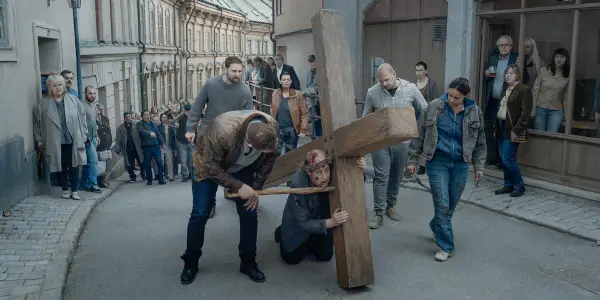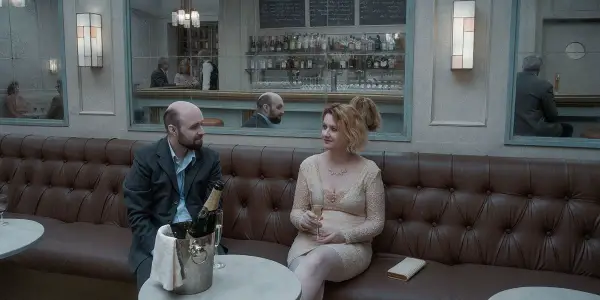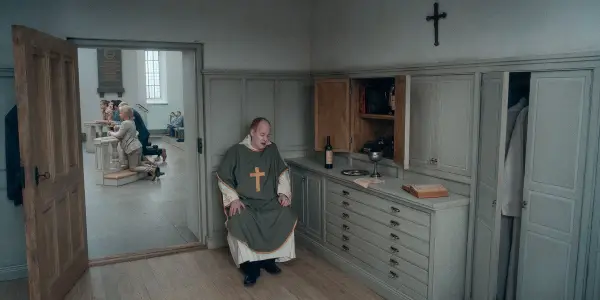ABOUT ENDLESSNESS: Roy Andersson’s Latest Is A Splendid Existential Work

Andrew Stover is a film critic/writer from the Chicagoland. His…
Swedish auteur Roy Andersson has been around for over 50 years, crafting films that are distinguished by an absurdist and quiescent style, wherein a static camera captures the natural state of characters in a staged environment. From Songs from the Second Floor (2000) to A Pigeon Sat on a Branch Reflecting on Existence (2014), Andersson habitually utilizes surreal humor to taunt the futility, tedium, beauty, and heartache of existence. With his recent work, About Endlessness, Andersson returns to familiar territory and provides more trenchant mirth and scathing insight into the human condition.
Andersson’s Latest Existential Offering Is An Intimate & Sublime Work Of Art
Unlike his earlier works, About Endlessness is more sedate and personal, as the sketches are more fugacious and equivocal. For 76-minutes, Andersson showcases micro-vignettes that are placed randomly throughout and narrated by an unseen girl, who is either omnipotent or going off of memory. Either way, every vignette begins with the girl saying, “I saw a man…” or “I saw a woman…” After a brief shot of a couple floating in the sky, the next scene captures an everyday couple looking at the clouds, unconcerned with the weight of the world and the cruel passing of time.

Throughout About Endlessness, palpable feelings of internal unrest play out in several vignettes. “I saw a man who wanted to surprise his wife with a nice dinner,” the narrator relays, and in fourth-wall-breaking fashion, the man speaks directly into the camera and recounts the time he ran into an old classmate who wouldn’t give him the time of day because of past wrongdoing; and in a later scene, the same man has animosity toward his old classmate because his classmate accomplished more in life. “I saw a woman, a communications manager, incapable of feeling shame,” the narrator imparts, and without any context, the immobile camera underscores the dejection plastered on the woman’s face. In numerous scenes scattered throughout, a priest deals with the loss of his faith, as envisioned in a dream in which the priest is hauling a cross through the streets of Stockholm. For the first time, the priest seeks advice from a listless therapist.
Instances of bliss are shown sporadically. At a bucolic cafe, three girls walk up and start dancing to the cafe music — and three young men sit nearby, watching as the girls lose themselves in the music without a care in the world. About halfway through, the floating couple — the same couple who graced viewers with their presence in the opening shot — becomes the focus of a majestic and liberating sequence above a ruined city, possibly conveying the idea that love can save us from sheer devastation. To counter the snippets of euphoria, Andersson occasionally appreciates an ambiance of dread by depicting a dour panorama of soldiers walking across rugged terrain in Siberia to their post-war imprisonment. Other sketches include an absentminded waiter, a man who lost his legs to a landmine, and a pair of grieving parents.
Stylistically Familiar But Still Wholly Effective & Heartfelt
About Endlessness is undeniably Andersson, compiled of seemingly unconnected sketches that strike a modestly dramatic and impassively comedic balance. The sketches encompass the banality of everyday life or bleaker glimpses of history with an enticing amalgamation of absurdity, transparency, and drollery.

The vignettes are undisrupted and shot from a distance, with a camera that has no sudden movements. Coupled with Gergely Palos’ multi-colored and gracefully inert cinematography and the film’s minimalist production design, Andersson conforms to his painterly tendencies to make every scene pop out like a painting. But similar to a painting, there are limitations to the scene as it places viewers in a precise moment of time. A man crying on a crowded bus, or a woman admiring the expensive champagne but not the man beside her, are deliberately insignificant moments, but every scene is a painting, and every painting has hidden strokes and details. Andersson’s framing is purposefully detached, drawing attention to background details that allude to context and symbolism and characters who surround the primary subject.
Andersson finds compatibility between the short bursts of rapture and despair which vividly separate each skit. Even a relatively crude skit at the psychiatrist’s office where the priest comes in looking for guidance outside of office hours and the shrink is more concerned with catching his bus ride home over helping the directionless priest, is uncomfortably funny and understatedly alarming. In this skit, Andersson exhibits the inanity of only helping others while working within a fixed schedule. Over the course of the film, the priest undergoes a crisis of faith which many formerly pious folk can relate to. More often than not for people of faith, their faith helps shape their identity, and when their faith crumbles, they are compelled to wonder who they are now.

Andersson documents characters drowning under the weight of isolation, depression, desperation, and boredom. He also documents characters who are swayed by unconditional, romantic, and unrequited love. While the past and present frequently overlap — collating positive and negative emotions at will — Andersson’s intentions are arguably lucid from the get-go. In life, we witness the good and the bad, the beauty and the unpleasantness, the monotony and the elation associated with living, akin to the uncertain trajectory of About Endlessness where the characters are confronted with everyday occurrences, inner turmoil, and the external plight of varying severity.
About Endlessness: Conclusion
With About Endlessness, Roy Andersson once again weaves together short vignettes that uncover the intricacy and vulnerability of the human condition. Despite staging the evocative sets and static camera in a visually rich, albeit intentionally synthetic manner, Andersson’s approach is still unfeigned, upheld by existential ruminations that convey reasons to exist and situations where those reasons evade our grasp. Roy Andersson remains a sapient and skilled filmmaker with a style that has yet to age — and likely never will.
Have you seen About Endlessness? If not, are you interested in seeing it now? Let us know in the comments!
About Endlessness will be released into theaters and on video-on-demand on April 30, 2021.
Watch About Endlessness
Does content like this matter to you?
Become a Member and support film journalism. Unlock access to all of Film Inquiry`s great articles. Join a community of like-minded readers who are passionate about cinema - get access to our private members Network, give back to independent filmmakers, and more.
Andrew Stover is a film critic/writer from the Chicagoland. His film & TV reviews can be found on Film Inquiry & Film Threat.












